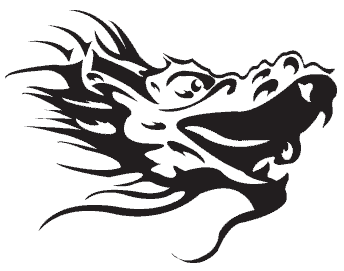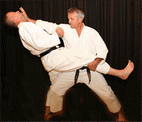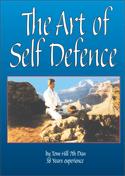Superinpei Kata
(Pichurin 108 hands))
Ryu Ryu Ku or Ryo-Ryo-Ko XIE-ZHONGXIANG (China).
Xie-Zhongxiang (AD1852-1930). A master of Shaolin Chuan-fa, known in Japanese as Ryo-Ryo-Ko (Ryu Ryu Ku), who lived in the Fujian Province of China. His system was based on the acupoint striking method originally founded by Feng-Yiquan in the early to mid 1500's, using variations of 36 (36, 72, 108 etc.). Xie-Zhongxiang went on to develop and expand this numeric concept by dividing, multiplying, etc. His students included the famous Higaonna-Kanryo, Miyagi-Chojun,and Nakaima-Norisato etc.
The cutural changes that took place in China during and after the Boxer Rebellion (1900) and the fall of the Qing Dynasty (1644-1911), little emphasis was placed on learning such complex martial arts. Those who learned the fighting arts after this period, did so as exercise, recreation or artistic performance. The wide-spread use of firearms reduced the need and effectiveness for hand-to-hand combat as a means to civil or self defense.
Suparinpei is found in the following styles of Chinese Boxing: Dragon, Tiger and Monk Fist.
Suparinpei (Pichurin 108 hands) is the most advanced Kata in Goju-Ryu. Initially it had three levels to master (Go, Chu, and Jo), later Miyagi left only one, the highest, "Jo" level. Occasionally referred to with the Funakoshi-altered name of Haiku Hachi Ho. Possibly created in the 1600s by Chinese General Ye Fai, this very old kata was later taught to Naha-te founder Kanryo Hiagonna circa 1868-1881 in the Fou Chou, (Fukien province of China) by Chinese Shorinji Kempo master Ryu Ryu Ku. It was passed on to Gojo-Ryu founder Chojun Miyagi, and Shito Ryu founder Kenwa Mabuni taught this kata to Otsuka. Suparinpei was listed in the 1939 kata list registered by Otsuka Sensei with the Dai Nippon Budokukai
It contains the largest number of techniques with variations repeated from other Kata. Suparinpei appears simple but when combined with transitions and changing tempos, it is only surpassed by Sanchin and Tenshio in technical difficulty and understanding.
The number '108' is thought to have origins in Buddhism and can represent the '108 sins of man'. On a Buddhist rosary there are 108 beads, 105 eulogize and 3 doctrine. On the Chinese New Year, temple bells are rung 108 times to 'drive away the evils of man'. It is believed this association with Buddhism is based upon the lack of factual knowledge of the true nature of these quan. However, it could be about the legend of the 108 men who robbed the rich and gave to the poor in the Chinese countryside of the 1600's. Also, there are considered 108 major stunning and killing points on the human body, according to the acupoint school originally established by Feng-Yiquan
Historians debate the significance of numbers in Kata names. There are many theories, the simplest being that the number was the amount of movements in the Kata when it was created. In ancient China, a charting system was created numbering the vital points on the human body and sets of movements were created to attack these points. As with most cultural phenomenon in China, there is also a definite Buddhist influence on some Kata names. The number 108 has great significance, specifically referring to the 108 defilements. This is reflected with the Kata as many of the Kata names are factors of 108, i.e. Gojushiho (54), Sanseiryu (36), Seipai (18). In many cases, kanji representations of Kata names are very recent. Kata names were unwritten until late in the last century. Prior to this, Kata names were often passed on through oral tradition. When karate-ka wanted to write the kanji down, it may have been that the writer didn't know the real meaning and simply used kanji that he thought represented the Kata in a phonetic sounding name of the Kata. It is an obvious possibility, it may not have been the original name at all. Because of this, there can sometimes be different kanji for the same Kata, or incorrect kanji altogether.
Warning:
If you perform any technique shown here in class or in public, you do so at your own risk.
We assume no responsibility for the use or misuse of the information provided which results in injury or loss.
Copyright: Tom Hill 2012 Goju.co.uk All rights reserved.
UPDATED 1st AUG 2020

































